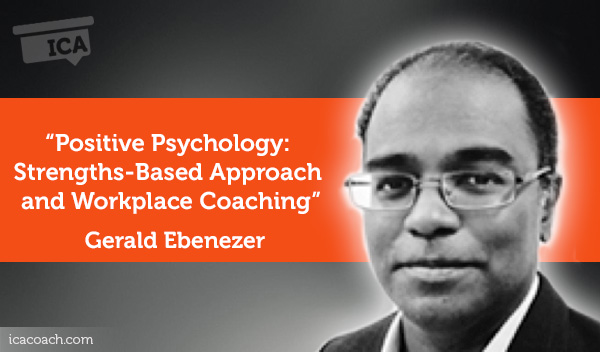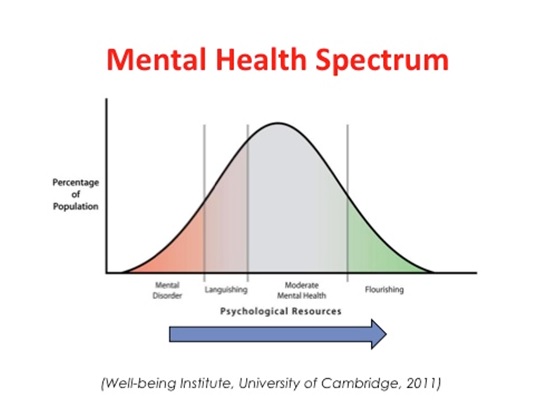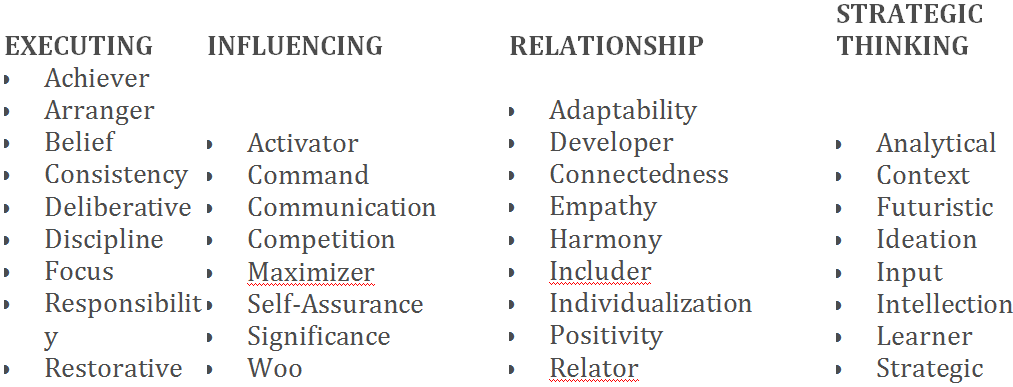
Research Paper By Gerald Ebenezer
(Executive Coach, MALAYSIA)
My interest in positive psychology was stirred as I realized whilst in my corporate career one instance of a mid-year performance review that I found particularly motivating. It boiled down to the leader who adopted a strengths-based approach in terms of focusing the discussion on my strengths rather than my weaknesses. This lead me to research this area and see what practitioners in the areas have found to be useful to influence high performance.
What is positive psychology?
Positive Psychology is the scientific study of human flourishing, and an applied approach to optimal functioning. It has also been defined as the study of the strengths and virtues that enable individuals, communities and organisations to thrive (Gable & Haidt, 2005, Sheldon & King, 2001).
Positive Psychology is grounded in the belief that people want to lead meaningful and fulfilling lives, to cultivate what is best within them, and to enhance their experiences of love, work, and play (Positive Psychology Center, 2016).
In 1998 Martin Seligman, American Psychological Association President, suggested that psychology turn toward understanding and building human strengths to complement the traditional emphasis on healing damage. Psychology had neglected the positive side of life, having spent much of the last half century primarily concerned with psychopathology. As a result, psychologists and psychiatrists can now measure with considerable precision, and effectively treat, a number of major mental illnesses. However, this progress came at a cost. Relieving life’s miseries made building the states that make life worth living less of a priority (Seligman, 2002).
One of the principle aims of Positive Psychology has been to correct this imbalance by propelling the field into supplementing its hard-won knowledge about suffering and mental illness with a great deal more knowledge about positive emotion.
Positive psychology represents a commitment to the sources of psychological wellness, such as positive emotions, positive experiences, positive environments, and human strengths and virtues (Lyubomirsky, 2007).
Four of the major aims of Positive Psychology:
- Rise to life’s challenges, make most of setbacks and adversity
- Engage and relate to other people
- Find fulfillment in creativity and productivity
- Look beyond oneself and help others to find lasting meaning, satisfaction, and wisdom (Keyes & Haidt, 2004)

Use your signature strengths and virtues in the service of something much larger than you are.~ Martin Seligman (2002, p. 263)
Martin Seligman is a pioneer of Positive Psychology (the term itself was coined by Abraham Maslow), not simply because he has a systematic theory about why happy people are happy, but because he uses the scientific method to explore it. Through the use of exhaustive questionnaires, Seligman found that the most satisfied, upbeat people were those who had discovered and exploited their unique combination of “signature strengths,” such as humanity, temperance and persistence. This vision of happiness combines the virtue ethics of Confucius, Mencius and Aristotle with modern psychological theories of motivation. Seligman’s conclusion is that happiness has three dimensions that can be cultivated: the Pleasant Life, the Good Life, and the Meaningful Life.
The Pleasant Life is realized if we learn to savor and appreciate such basic pleasures as companionship, the natural environment and our bodily needs. We can remain pleasantly stuck at this stage or we can go on to experience the Good Life, which is achieved through discovering our unique virtues and strengths, and employing them creatively to enhance our lives. According to modern theories of self-esteem life is only genuinely satisfying if we discover value within ourselves. Yet one of the best ways of discovering this value is by nourishing our unique strengths in contributing to the happiness of our fellow humans. Consequently the final stage is the Meaningful Life, in which we find a deep sense of fulfillment by employing our unique strengths for a purpose greater than ourselves. The genius of Seligman’s theory is that it reconciles two conflicting views of human happiness, the individualistic approach, which emphasizes that we should take care of ourselves and nurture our own strengths, and the altruistic approach, which tends to downplay individuality and emphasizes sacrifice for the greater purpose.
[Positive Psychology] takes you through the countryside of pleasure and gratification, up into the high country of strength and virtue, and finally to the peaks of lasting fulfillment: meaning and purpose (Seligman 2002, p. 61).
According to Seligman, we can experience three kinds of happiness: 1) pleasure and gratification, 2) embodiment of strengths and virtues and 3) meaning and purpose. Each kind of happiness is linked to positive emotion but from his quote, you can see that in his mind there is a progression from the first type of happiness of pleasure/gratification to strengths/virtues and finally meaning/purpose.
Strengths-based approach
The Gallup Survey has shown that employees who are focusing on their strengths are six times more engaged.
Hence, here is an opportunity for the coach to bring the awareness of the coachee to his or her strengths. A number of online tools exists that can uncover the strengths of the coachee.
- VIA survey – visit www.viasurvey.org and complete the VIA Inventory of Strengths Survey.
- Visit www.gallupstrengthscenter.com/purchase and take an online assessment and receive your Strenghths Discovery Package for less than USD 10.
- The Clifton StrengthsFinder™ measures the presence of 34 talent themes (Talents are people’s naturally recurring patterns of thought, feeling, or behavior that can be productively applied). The more dominant a theme is in a person, the greater the theme’s impact on that person’s behavior and performance.
Once you know which of the 34 themes — such as Achiever, Activator, Empathy, Futuristic, or Strategic — you lead with, you can leverage them for powerful results at three levels: for your own development, for your success as a manager, and for the success of your organization.
StrengthsFinder® is a valuable tool for leaders and in Strengths Based Leadership, authors Tom Rath and Barry Conchie discovered in their research that there are four domains of leadership strength — executing, influencing, relationship building, and strategic thinking.
Four Domains of Leadership Strength
Executing
Team members who have a dominant strength in the Executing domain are those whom you turn to time and again to implement a solution. These are the people who will work tirelessly to get something done. People who are strong in the Executing domain have an ability to take an idea and transform it into reality within the organization they lead.
Influencing
People who are innately good at influencing are always selling the team’s ideas inside and outside the organization. When you need someone to take charge, speak up, and make sure your group is heard, look to someone with the strength to influence.
Relationship Building
Relationship builders are the glue that holds a team together. Strengths associated with bringing people together — whether it is by keeping distractions at bay or keeping the collective energy high — transform a group of individuals into a team capable of carrying out complex projects and goals.
Strategic Thinking
Those who are able to keep people focused on “what they could” be are constantly pulling a team and its members into the future. They continually absorb and analyze information and help the team make better decisions.
StrengthsFinder® Leadership Domains
The StrengthsFinder® themes are organized into the Leadership Domains as follows:
 Leveraging strengths has become guiding philosophy of many leaders, managers and corporations in recent years. The popularity of tools such as StrengthsFinder 2.0 has given managers and employees a simple way to discuss strengths as part of a performance review.
Leveraging strengths has become guiding philosophy of many leaders, managers and corporations in recent years. The popularity of tools such as StrengthsFinder 2.0 has given managers and employees a simple way to discuss strengths as part of a performance review.
Application of Strengths-based approach at work
There are a number of opportunities where the strengths based approach can be brought into the organization to immense benefit. Authors Margaret Greenberg and Senia Maymin in their book, Profit from the Positive, highlight how this can be done.
Mindset of the leader
Strengths-based leaders focus on what people do well rather than on their weaknesses. There are hidden perspectives that we carry that need to be reframed in order to shift the focus to being a strengths-based leader. These perspectives revolve around mainly treating employees as “problems to be solved” and our brains are hardwired to the negative.
- Stop asking the wrong questions. Instead of only studying “what went wrong”, study what is being done well so that it can be replicated.
- Share success stories. Ask questions on why one area, team or person is outperforming another. Share those success stories and then replicate these practices in other areas.
- Find solutions, not faults. Talk through the ideas your employees have to solve problems using a coaching conversation approach. Facilitate finding the solutions with your team.
- Encourage bad news. Ask questions that promote solutions and ownership such as:
a) Without placing blame, how do you think we got here?
b) What are some short-term possibilities? Long-term?
c) What would you do if you were the boss?
- Know thyself. To become a strengths-based leader, you must know thyself. Other than doing surveys, as yourself:
a) What am I really good at?
b) What kind of work really energizes me?
c) When am I at my best
Job crafting
Job crafting is an intentional process that is facilitated by a leader to create a better fit between the requirements of the job and the strengths of the employee performing it.
In dealing with particular work challenges employees may be facing, the coach or Manager could ask – How do you think you could apply one of your strengths to this assignment?
Celebrating Team Differences
In a team environment, the leader could facilitate a group meeting to understand the strengths of the team after each one has completed an online assessment.
Going around the room, the leader can pose the following questions and capture the feedback for everyone to visualize.
- What do you see as your key strengths?
- What could you do to leverage this strength to execute the business strategy?
Once this is evident, the leader could use this insight to assign roles and responsibilities that truly energize the team.
Addressing Poor Performance
Barring external factors, one of the most common causes of the poor performance is the poor fit between the skill level of the employee and the level of the challenge.
Rather than having a progressive discipline discussion, leaders can have a flow discussion instead. The steps are as follow:
- Acknowledge the issue objectively eg I noticed that the turnaround on the reports has gone down last couple of weeks
- What seems to be getting in the way? When the employee is unsure of the reasons, then there is an opportunity to activate the flow discussion.
- I came across this chart and I think it applies to us at different times in our careers. Drawing the chart out, the leader could ask the following questions:
a) When it comes to processing the reports, where do you think you are on the Flow chart in terms of the level of skill and in terms of the level of challenge?
b) What could I do to get you in the flow channel more often?
Frequent Recognition & Encouragement – Use “Process Praise”
Research by Carol Dweck of Stanford University has found that process praise is more effective than person praise. Person praise inculcates a sense of helplessness and fear of losing the positive reputation if the person makes a mistake. On the other hand, process praise is found to promote more self-confidence and resilience especially when they are faced with future difficulties.
Performance Reviews
a) Spend more time on strengths instead of weaknesses during conversation.
Spend more time in the performance review discussing what employees have done well and how they can use their strengths in new and different ways in the weeks and months ahead. The weakness would also be addressed in terms of what is needed to plug the gaps but this is not the focus of the conversation.
b) Speak and write the same language as their strengths indicators.
Here is an opportunity to use strengths-based descriptors such as “Achiever; Analytical; Learner; Strategic” in the performance review.
c) Make goals clear and specific for performance-oriented matters
Difficult and specific goals (with progressive milestones) lead to significantly higher performance than do easy or vague goals. When effective goals are set, employees know what effective performance looks like and that makes the job of providing constructive feedback much easier later on.
d) Preview performance
Ask employees to write their goals for the upcoming year from the perspective that they have already attained them. Imagine, that it is a year from now and you are writing your performance review – What would you have to say about what you accomplished?
Research has shown that those who visualize how they will achieve their performance targets performed better than those who only imagined meeting their performance targets. Hence, also include the ‘process aspect’ of the performance in ‘previewing performance’. Imagine it is a year from now and you are writing about how you accomplished the results that you achieved. “How would you go about describing the process you used for delivering the results?”
e) No surprise rule
Seek to provide feedback as close to when the behavior is being observed. The “no surprise rule’ would mean that the employee is already aware of the matters that would be discussed during the performance conversation as it has bee discussed earlier.
f) Giving tough feedback
Treat it like a conversation and use the following approach:
- Describe what seems to be working and the demonstrated strengths of the employee
- Speak about the gap in the context of it being an opportunity that can be taken advantage of right now to benefit a higher goal and how it would also benefit the employee in both the short and long-term
- Ask the employee “ what could you do differently?” to resolve the under performance issue.
References
http://www.pursuit-of-happiness.org/history-of-happiness/martin-seligman-psychology/
Greenberg, M., & Maymin, S. (2013). Profit from the positive: Proven leadership strategies to boost productivity and transform your business. New York: McGraw-Hill.